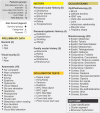Artificial intelligence virtual assistants in primary eye care practice
- PMID: 39723633
- PMCID: PMC11823310
- DOI: 10.1111/opo.13435
Artificial intelligence virtual assistants in primary eye care practice
Abstract
Purpose: To propose a novel artificial intelligence (AI)-based virtual assistant trained on tabular clinical data that can provide decision-making support in primary eye care practice and optometry education programmes.
Method: Anonymised clinical data from 1125 complete optometric examinations (2250 eyes; 63% women, 37% men) were used to train different machine learning algorithm models to predict eye examination classification (refractive, binocular vision dysfunction, ocular disorder or any combination of these three options). After modelling, adjustment, mining and preprocessing (one-hot encoding and SMOTE techniques), 75 input (preliminary data, history, oculomotor test and ocular examinations) and three output (refractive, binocular vision status and eye disease) features were defined. The data were split into training (80%) and test (20%) sets. Five machine learning algorithms were trained, and the best algorithms were subjected to fivefold cross-validation. Model performance was evaluated for accuracy, precision, sensitivity, F1 score and specificity.
Results: The random forest algorithm was the best for classifying eye examination results with a performance >95.2% (based on 35 input features from preliminary data and history), to propose a subclassification of ocular disorders with a performance >98.1% (based on 65 features from preliminary data, history and ocular examinations) and to differentiate binocular vision dysfunctions with a performance >99.7% (based on 30 features from preliminary data and oculomotor tests). These models were integrated into a responsive web application, available in three languages, allowing intuitive access to the AI models via conventional clinical terms.
Conclusions: An AI-based virtual assistant that performed well in predicting patient classification, eye disorders or binocular vision dysfunction has been developed with potential use in primary eye care practice and education programmes.
Keywords: artificial intelligence; clinical decision support; machine learning; optometry; virtual assistant.
© 2024 The Author(s). Ophthalmic and Physiological Optics published by John Wiley & Sons Ltd on behalf of College of Optometrists.
Conflict of interest statement
None of the authors has a financial or proprietary interest in any material or method mentioned. Additionally, the authors declare that this research received no specific grant from any funding agency in the public, commercial or not‐for‐profit sectors.
Figures





Similar articles
-
An Advanced Machine Learning Model for a Web-Based Artificial Intelligence-Based Clinical Decision Support System Application: Model Development and Validation Study.J Med Internet Res. 2024 Sep 4;26:e56022. doi: 10.2196/56022. J Med Internet Res. 2024. PMID: 39231422 Free PMC article.
-
Comparison of Chest Radiograph Interpretations by Artificial Intelligence Algorithm vs Radiology Residents.JAMA Netw Open. 2020 Oct 1;3(10):e2022779. doi: 10.1001/jamanetworkopen.2020.22779. JAMA Netw Open. 2020. PMID: 33034642 Free PMC article.
-
Artificial Intelligence Distinguishes Surgical Training Levels in a Virtual Reality Spinal Task.J Bone Joint Surg Am. 2019 Dec 4;101(23):e127. doi: 10.2106/JBJS.18.01197. J Bone Joint Surg Am. 2019. PMID: 31800431 Free PMC article.
-
Role of Machine Learning and Artificial Intelligence in the Diagnosis and Treatment of Refractive Errors for Enhanced Eye Care: A Systematic Review.Cureus. 2024 Apr 6;16(4):e57706. doi: 10.7759/cureus.57706. eCollection 2024 Apr. Cureus. 2024. PMID: 38711688 Free PMC article. Review.
-
Artificial Intelligence in Optometry: Current and Future Perspectives.Clin Optom (Auckl). 2025 Mar 12;17:83-114. doi: 10.2147/OPTO.S494911. eCollection 2025. Clin Optom (Auckl). 2025. PMID: 40094103 Free PMC article. Review.
Cited by
-
Artificial intelligence in ophthalmology: opportunities, challenges, and ethical considerations.Med Hypothesis Discov Innov Ophthalmol. 2025 May 10;14(1):255-272. doi: 10.51329/mehdiophthal1517. eCollection 2025 Spring. Med Hypothesis Discov Innov Ophthalmol. 2025. PMID: 40453785 Free PMC article. Review.
References
-
- Oke I, VanderVeen D. Machine learning applications in pediatric ophthalmology. Semin Ophthalmol. 2021;36:210–217. - PubMed
MeSH terms
LinkOut - more resources
Full Text Sources
Medical

